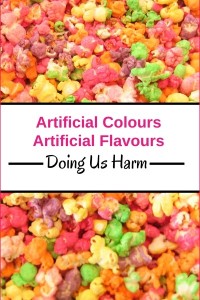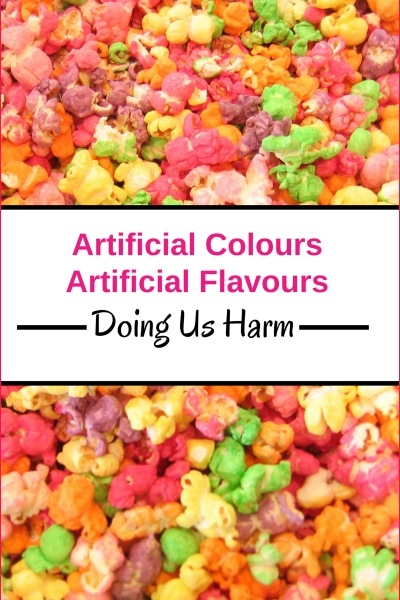 Food Artificial Additives And Preservatives Causing Us Serious Harm
Food Artificial Additives And Preservatives Causing Us Serious Harm
Brightly coloured and synthetically flavoured cakes, lollies, ice-creams, biscuits, chips, sauces and other snack and highly processed foods, entice not only kids but us adults too. In this article Food Artificial Additives And Preservatives Causing Us Serious Harm, I will unearth the facts about what goes into processed foods.
While these foods look appealing and taste great, for the sake of ours and our family’s health, especially our children’s health, we really need to rein in our cravings and think twice before indulging. Just because they are on the shelves does not mean they are safe to eat!
Artificial Food Colours and Flavours Making Us Sick
Many of the artificial colours, preservatives, flavour enhancers and other additives added to processed food are very dangerous for our health and long term consumption of these chemical food ingredients can lead to serious life threatening illnesses such as cancer .
Consuming artificial food colours, additives and preservatives can also cause immediate allergic type reactions eg. rashes, nausea, diarrhea and also hyperactivity in sensitive children. Artificial-colours-in-food-linked-to-cancer-and-behavioral-disorders-in-children.
How many parents have witnessed first hand, the uncontrollable, hyperactive effects, red food dye in cordial and lollies has on their children?
The Serious Health Concerns Of Tartrazine , Yellow Food Colour
Tartrazine is a yellow food colourant that is widely used in children’s foods and is even fed to egg laying hens to make the yolk of their eggs a more appealing yellow.
Tartrazine has been shown to cause a whole host of diseases and here are just some of them, Cancer, Eosinophilia, DNA damage, Asthma, OCD, Heart Palpitations, Eczema, Anxiety, ADHD. Read more here.
Two brave mothers have taken it upon themselves to raise awareness about the dangers of children eating a well known macaroni and cheese brand that contains the yellow food colourings yellow 5 Tartrazine and yellow 6 which contain benzidine 4-amino-buphenyl, a man-made product derived from petroleum. Read about their inspiring and courageous campaign here.
See also Kraft Under Pressure Over Cancer Causing Yellow Food Coloring
The Dangers Of Food Additives, Preservatives & Food Stabilizers
Even if you choose to stay away from artificial colouring and flavouring you need to watch out for a host of other food menaces, namely additives, preservatives and Stabilizers. Some of the really nasty commonly used ones are, preservatives sodium benzoate (211) and sulphur dioxide (220); artificial sweeteners aspartame (951) and saccharin (954); flavour enhancers MSG (621) and disodium 5’-ribonucleotides (635).
Bill Statham author of the highly acclaimed book ‘The Chemical Maze’ states,“These food additives cause or exacerbate complaints like asthma, hyperactivity, skin rashes, headaches and migraines to name a few conditions. They may also be associated with organ dysfunction, reproductive abnormalities, birth defects and cancer”.The Chemical Maze- Food Additives & Labelling
When we pick up a processed loaf of bread in the supermarket, most of us tend to read the front and overlook the ingredients listed on the back, especially as they are usually in some obscure place on the packaging and in tiny print.
Promises of high-fiber, added iron and omega 3’s are all very enticing and give the illusion that eating a bread fortified with such vitamins will promote good health but… if you take a look at the fine print, often the list of artificial preservatives, stabilizers, colours and flavourings, (usually listed as numbers – which means nothing to the average person) do the exact opposite and can compromise our health.
Note the difference when you buy bread fresh from a bakery, you will find it will only remain soft and fresh for a couple days at the very most, but when you buy highly processed packaged bread, it can stay soft and pliable for a week!
 How To Avoid Food Additives
How To Avoid Food Additives
The most important thing is awareness when shopping for food. A simple rule of thumb is if you don’t know what an ingredient is don’t eat it!
When the ingredients that make up a food item are listed as a numbered code, then you should think twice before consuming it.
Not all numbers are necessarily bad, but you really need to know what each number stands for to decipher the good from bad food additives. Here is a very handy site that lists what all these food number codes stand for Food Additives
When shopping don’t just trust the bold and clever advertising on the front of a package, turn over and read the entire ingredients before deciding to buy the product
- Steer clear of food products which have a huge list of ingredients that are listed as either long winded chemical names, or in numbers. Pick products with as few ingredients as possible, as less is more.
- Find alternatives to artificial food colours. Try experimenting by making your own natural colours when you are making sweets or icing cakes. Fruits, vegetables and even spices like beetroot, blueberry, carrot, turmeric and spinach will make great reds, blues, oranges, yellows and greens. See my recipe for Using Beetroots Make Vegan, Natural Red Food Colouring
- Some natural food colourants that are not good for you either, steer clear of 160b Annatto, which although natural cause reactions in children and adults such as headaches, sleep disturbances, irritability and more read here
- Also be aware that not all antioxidants in foods are good for you. The food antioxidant 320 butylated hydroxyanisole is actually a potential carcinogen and is commonly found in food products such as margarine’s, spreads, salad dressings, some nuts etc.
- Natural red food colour comes from crushed dead beetles, so if you are vegan or vegetarian avoid the following “Cochineal,” “Cochineal Extract,” “Carmine,” “Crimson Lake,” “Natural Red 4,” “C.I. 75470,” or “E120.
- Cook with natural produce at home like our grandmothers did. Many of us have forgotten the pleasures of eating something fresh off the stove. Aim to use fresh, natural and if you can organic ingredients. If you are busy, cook up a big batch and freeze in small containers,this way you always have something on hand
- If you have a sweet tooth, try making your own toffee’s, ice-cream, cakes and sorbets.
- At the very least, always look for products that state on the packaging that they contain no artificial colours, flavours and preservatives. Check that they are free from 320 and 160b.
- When buying packaged and processed food where possible buy ‘certified’ organic produce. Certified Organic products tends to be closer to a natural state and organic manufacturers really do everything they can to minimize adding anything dangerous or artificial. See Why Organic Food Really is Healthier.
Before you leave, if you enjoyed this article sign up to LivingSafe and stay informed! LivingSafe helping you live healthier & safer.
Articles you may find interesting are;
Why Organic Food Really is Healthier.
Additive Free, Organic, Vegan Kids Birthday Cake Recipes and Ideas & Natural Fondant Recipe
Raw Coconut Oil Health Benefits and Uses
How To Live A Cruelty Free Lifestyle Checklist
Animal Testing Of Cosmetics Do Your Part To Stop It
Cleaning Your Home Naturally & Safely With Vinegar and Bicarb
Leave a Reply
You must be logged in to post a comment.